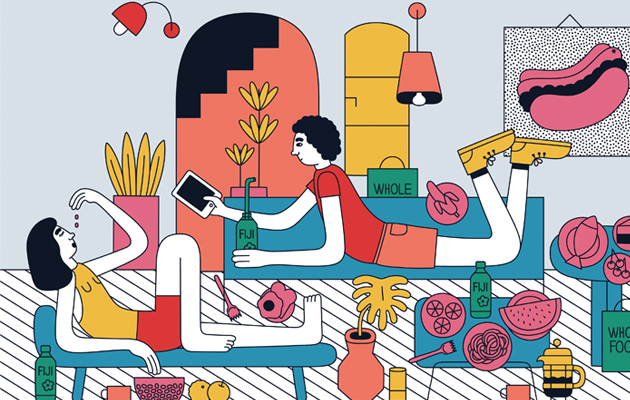|
|
||
|
Over-indulging on food has always been a symbol of wealth and status. But today, it’s not the produce that counts – it’s the packaging Of all of the deadly sins, gluttony is perhaps the most overtly physical – it has always depended on the literal act of consumption, of taking in large quantities of rich and unhealthy food. With its etymology coming through the Latin gluttire, meaning to swallow or to gulp down, there is a visceral connotation that immediately conjures images of expanding waistlines, gout-infested limbs, and foreheads glistening with a shine brought on by the “meat sweats”. The glutton has always been regarded as one who gorges unrestrained, with no consideration about the consequences, either for themselves or those around them; they are driven by incessant greed and a singular desire to satisfy themselves. The excessive consumption of food has long been used as a signifier of wealth and power. From the banquets of ancient Rome to the feasts of the 17th-century French court, a guaranteed method of distinguishing yourself has been through extravagant meals. And so the vice of indulgent over-eating has always been related to appearance: the creation of a specific image that portrays the particular status of the individual. Today, food is still used to signify class distinctions. However, rather than the produce itself, it is the packages that act as the most effective status symbols. In a modern capitalist economy, the connotations of gluttony have become intrinsically connected with consumerism. With an industrialised system of mass production and distribution, food has become less of a raw commodity and more of a polished product; as a result the emphasis on its use has noticeably shifted. Now, as much as to sustain ourselves, we buy these “things” to become associated with them, to construct an image of ourselves, and it is through this association that we mediate our relationships with each other and the world around us. A prime example of this can be found by looking at bottled water, and in particular Fiji Water, which epitomises this consumerist approach to the purchase of food and drink. On the label, the image of a pink hibiscus floats atop a refreshing blue gradient that fades across the bottle, dark to light, as if you were staring into an ever-deepening lagoon. The tall, slender, condensed typeface that spells out the name of both the place and the product, “Fiji”, is outlined in gold, glinting like the sun on the waves as it begins to set above the tropical paradise. It is an appealing brand to buy into, with an aesthetic that is made for Instagram, conjuring idealised images of white sand beaches and luscious rainforests. Everything about the bottle communicates a carefree, modern approach to healthy living and suggests an aspirational purity towards which we can all aim. But, paradoxical as it may seem, I would argue that these bottles represent the truest expression of the concept of gluttony today. There is an undeniable extravagance involved when we pay hand over fist for water that has been shipped from a “pristine” Pacific island, “bottled at the source, untouched by man”. This is particularly obscene if we consider that there are issues of local access to clean water in the very place that it has originated. Our own thirst could, of course, be easily quenched by the perhaps less desirable stuff that comes out of the tap, but this does not come with the exotic back story, the slightly more delicate flavour or, most importantly, the specific and recognisable packaging that allows the supposed qualities of the product to become associated with us. Over recent years, there has been a steady increase in companies capitalising on the consumer desire for natural, “authentic” products as they strive for individuality in the face of an increasingly homogenised, globalised landscape. If a small packet of mixed nuts can be on sale for upwards of £7, then there is clearly more to these products’ market value than just their ability to sustain the consumer. This rise in the numbers of smaller retailers specialising in organic, natural products and wholesome, healthy foods in fact only fuels this new model of consumerist gluttony, as the items that they sell have become essentially symbolic. In this regard, packaging is now the most valuable asset of the products that we buy, with the properties of the food itself reduced to a secondary element. So the once unassuming aesthetic of brown paper, string, perhaps even a faux-letterpress typeface – so far removed from the lurid plastics of an industrialised process – now screams of a rustic chicness in which “authenticity” has become the new “luxury”. From local independent greengrocers and artisan bakeries to chains like Whole Foods Market, recycled-paper shopping bags have become ubiquitous on the high streets of affluent areas. The muted brown and green colour palette of a Whole Foods bag, in particular, has come to signify wealth and sophistication through its apparent separation from the mass culture of ordinary supermarket shopping. It has an earthy quality to it, harking back to the fields from which the produce originated, but at Whole Foods the consumer can access this “authentic” experience without actually having to deal with the grubby realities of the natural world. Of course, it is hard to argue with the sentiments of encouraging healthy eating. And in many cases organic produce, however it is packaged, allows just that. It does seem, though, that we are living in a society that considers a product’s value through the lens of what it can communicate as opposed to what it actually is. Surely, by approaching food shopping simply as an activity for the construction of self-image, we are enacting the most luxurious indulgence of them all. This article first appeared in Icon 147: Sins |
Words Robert Hetherington
Illustration Martina Paukova |
|
|
||

















